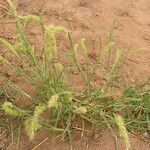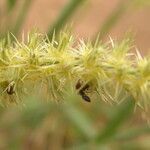Annual, tufted, up to 0.8 m high. Leaf blades 60-350 mm long, 4-10 mm wide. Spikelets 5 mm long, 4 mm wide. Inflorescence a false spike 20-100 mm long; spikelet involucre in 2 whorls, inner whorl with connate spines which are plumose on their inner surface and with 1-3 shallow grooves on their outer surface, outer whorl bristle-like and short, 40-60 spines; base of burr with a distinct ovoid disc.
An annual grass. It grows 10-60 cm high. It forms tufts. It has runners, The leaves are alternate and simple. They are 2-25 cm long and 2-7 cm wide. The flowers are green. They are in a spike like panicle. This is 2-15 cm long and has 1-3 spikelets.
Pending.


